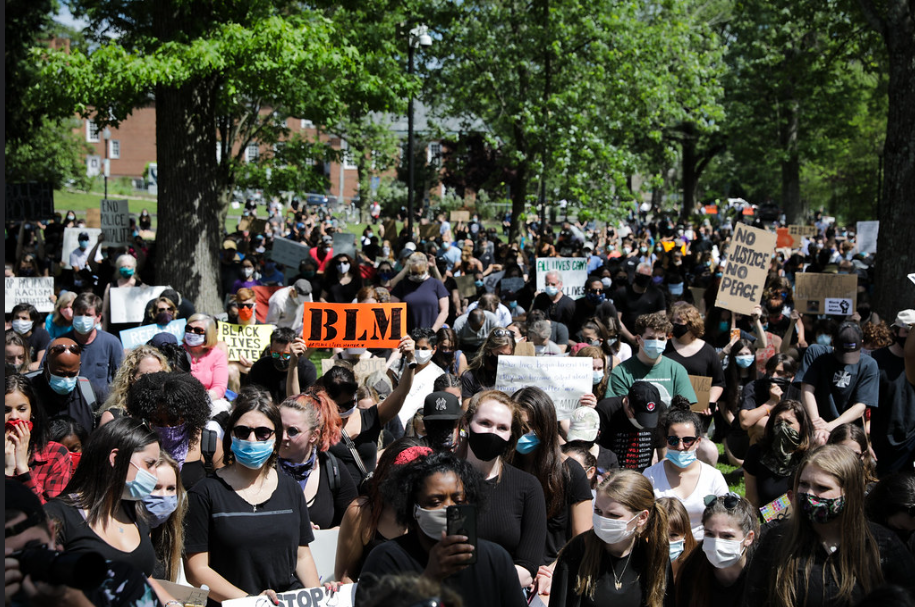Our Great Wealth-Race Divide: COVID’s Preexisting Condition

Headed into Easter its the horrific images coming out of the Ukraine, along with images of Will Smith slapping Chris Rock, that’s pushed the ongoing pandemic off the ‘breaking’ news page. Even as we are just days away from blowing past the one million deaths in the U.S. threshold, the social media analytics that now inform news judgements, have moved on to other more profitable topics to support the advertizers.
There is little news media appetite to double back and take an in depth look at the social preexisting conditions that set the stage for the COVID mass death event in which poor people of color died at an exponentially higher rate than wealthier whites here in New Jersey and throughout the rest of the country. The Democratically controlled Congress could not even muster the moral coverage to raise the $7.25 federal minimum wage nor continue the expanded Expanded Child Tax Credit, which briefly lifted millions of children out of poverty.
Last week, Rev. Dr. William Barber’s Poor People’s Campaign released the first of its kind comprehensive study of COVID deaths in over 3,000 U.S. counties that plugged in the intersectionality of poverty, income, race and geography. The research is part of the campaign’s national organizing drive culminating in the June 18 Poor People’s and Low Wage Workers’ Assembly and Moral March on Washington.
“The findings we will hear today are shameful and will shock us, because, as a nation, we do not talk about poverty,” Barber told reporters April 4 at a press conference at the National press Club that InsiderNJ monitored. “Yet in the pandemic, we will hear that there have been 2, 3, 4, 5 times the deaths in poorer communities as in richer ones….We encourage everyone here to walk through the data after this conference and take the time to see what has been so far unseen. The findings are so contrary to a nation that claims first and foremost to establish justice and certainly contrary to the call of God to care for the least of these.”
Rev. Barber continued. “Remember, this unnecessary death happened while we gave corporations $2 trillion to keep them alive and the richest Americans saw their wealth soar. It’s a gross example of what Naomi Klein has called the ‘shock doctrine,’ when the wealthy exploit tragedy to increase their own profits while poor people suffer.This report shows that a poverty-producing and sustaining system was also a death-dealing system. Within this analysis, we can see that it did not need to be this way, if only we were honest about poverty and systemic racism, and the systems of violence that allowed this tragedy.”
The Poor People’s white paper was co-authored by renowned economist Jeffrey Sachs with the UN Sustainable Development Solutions Network and was released the same day as a deeply disturbing analysis released by the United Way of Northern New Jersey and its research arm United For ALICE which found that 63 percent of New Jersey’s Black children and 60 percent of our Hispanic children were living in “financial hard pre-pandemic.”
A GARDEN OF UNEVEN
Out of New Jersey’s 1.926 million children, 41 percent are below the ALICE survival threshold and almost 60 percent of those are “rent-burdened” paying 35 percent of their income for shelter and one in four have no access to high-speed internet, while almost one in three are not getting food stamps (SNAP benefits).
The New Jersey data was part of a comprehensive state by state United Way analysis entitled Children in Financial Hardship that looked at children living below the official federal poverty level and households earning above that but who struggle week to week to cover the essential expenses like rent, utilities, food, childcare. Back in 2009, United Way researchers started tracking these families they dubbed ALICE, which stands for being asset limited, income constrained, but employed.
Nationally, the United Way found nearly half of the children in the United States lived in households that were “experiencing financial hardship” with 16 percent below the federal poverty level while 33 percent were above that threshold, yet still struggling to cover the basics. While ALICE families are evident in every demographic, the racial disparities are stark. Nationally, 70 percent of Black children and 68 percent of Hispanic children are living below the ALICE threshold, as compared to 36 percent of white children.
In raw numbers, out of the 72 million children in the country, 36 million live below the ALICE threshold, which includes the 12 million below the official federal poverty level.
Follow-up analysis by the United Way in the midst of the pandemic showed that once COVID hit, these struggling families saw thing go from bad to worse.
“COVID-19 hit ALICE families so much harder than others because they struggle to build savings yet often don’t qualify for financial assistance,” said ALICE National Director Stephanie Hoopes. According to the ALICE Project’s research, “half of the New Jersey families below the ALICE threshold reported in the fall of 2021 that their children “sometimes or often” didn’t have enough to eat, as compared to 32 percent of those with higher incomes.
In addition to food insecurity, children in ALICE households were more likely to be subject to “interrupted learning and skipping preventative healthcare,” according to Hoopes.
The gap between the prevailing wage for certain jobs like cashier or home healthcare aide and the actual cost of living, looms even larger in a period of high inflation, like the we currently experiencing. For instance, 79 percent of children who have a parent who works as a cashier, that pays a median wage of $11.37 are in an ALICE household. Back in 2019, ALICE researchers found that in New Jersey for economic stability a single wage earner would need to be getting $22 an hour and $55 dollar per hour for a family of four.
Governor Murphy made raising the state’s minimum wage a top priority. This year it went up to $13 an hour and is scheduled to hit $15 by 2024. There are cut outs for seasonal, agricultural, small businesses and workers who also get tips.
CHASING SURVIVAL
The ongoing pandemic has continued to roil the labor market where employers are complaining they can’t find enough workers. According to the Bureau of Labor Statistics last year wages grew by 4.5 percent, the biggest spike since 1983. But when inflation is factored in, workers continued to lose ground.
“The earning power of working people has been held in check for decades and by there are structural reasons for it,” Sachs told InsiderNJ. “Of course, we have had the weakening of unions—the busting of unions, the move to the digital economy has been another aspect. Gig work has been part of it and then there’s the tax policies that have pushed so much money to the top.”
Sachs said that the United States does not have any social safety net for working Americans, like those ALICE households, many of whom are essential workers. This cohort often lacks the basic benefits that used to be provided as part of the social contract between employees and employer.
“So, we have tens of millions of people in the precariat economy that are just vulnerable to whatever is going to happen next because our political system is so plutocratic, rotten and nasty,” said Sachs. “The millionaires in Congress, like Sen. Joe Manchin, who represents West Virginia, one of the poorest places in the country, has instincts and politics that has him siding with the gazillionaires.”
Sachs points out that social net programs, like subsidized universal pre-K or childcare that are widely accepted in Canada, and other western democracies, could actually lift up so many ALICE families. Yet, they are stymied in the beltway as “grand debates because our country is uniquely mean at the top because rich people are mean. They don’t want a small amount of help to go to poor women that are trying to raise kids even in a pandemic even with a massive increase of wealth at the top.”
Perhaps, for wealthy Washington policy makers it’s hard to put a face on these tragic data points of deprivation.
A FACE I NEVER FORGET
Almost 20 years ago, I grabbed one of the last seats at the funeral of 7 year-old Faheem Williams at the Emmanuel Church of Christ in Newark. His body had been found in a plastic storage bin in a home in Newark in January of 2003. The little boy had died from a fall in Irvington several months earlier and his family didn’t seek medical attention.
Senator Frank Lautenberg, Governor James McGreevey, as well as Newark Mayor Sharpe James, all spoke to the packed congregation. For a few weeks, the specific cruelty of how the 7 year-old was treated and the failures of New Jersey’s Division of Youth and Family Services made national headlines.
“It was one of New Jersey’s most gruesome child abuse cases, a 7-year-old boy’s mummified body stuffed into a plastic container only a few feet from where his two starving brothers were kept in a locked basement with a bucket for a toilet,” reported the New York Times at the time. “The family had been investigated for child abuse or neglect 10 times over as many years, but a caseworker overwhelmed by 107 other cases failed to follow up on a report several months before the boys’ discovery that they were being beaten and burned.”
I have kept the laminated mass card with Faheem’s picture on it that the Star Ledger described made him look “pensive.” I think he knew something, everything in his life was amiss. I have held on to his palm card to remind me that every news story I do is about actual people.
At the time, I was covering the case for WNYC. I was struck by the cruel irony that his funeral was so well attended, yet the times that mattered most in his short life he was so very much alone.










Leave a Reply